WATER
finding water, storing, filtering and using it...
you’re not sure about how to secure the most important resource ?
This is an introduction, an overview of everything water-related.
We're going to talk about ,
~ways to gather it,
~rivers
~source
~ground water
~rain water
~dessalinisation
~fog catchers
~atmospheric water generator
~ ways to store it,
~plastic tanks
~steel tank
~plyuwood fiber glass
~ferrocement
~bricks
~in the landscape
~moving water with pumps
~Usage
~water systems
~filtering
~saving water
~grey water sys.
Gathering water
So best case scenario, you have water readily available at ground level on your land, a little stream passing by or even a river…
You could have a intake pipe at the bottom of the river but its quickly gonna get clogged, so you could have it floating mid stream instead…
But to get even cleaner water and a maintenance free system, I would advise you not to take the water directly from the stream but rather, tap in the underground water surrounding that stream.
You could Make something like an enclosed, buried mini well so that you collect water that was pre filtered by the soil.
That will help to avoid surface contamination due to eventual animal carcasses or other nasty things higher up, in the stream but also that system is more resilient to freezing and requires minimal maintenance.
On top of that with such a system you are much less likely to draw too much water from the stream and damaging its ecosystem… make sure to not take to much water, but still have plenty water available by building a large storage capacity.
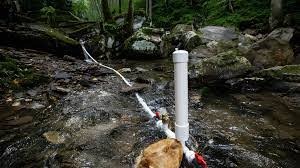


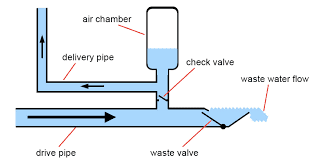
If your source is higher than your house You could then refill your tank simply with gravity, much better than using a pump because gravity rarely breaks down…
You can use about any type of piping, flexible, pvc, etc.. burry it if you want to protect it from the freezing or for animal or vehicule passage.
The simplicity and resiliency of that system is great.
Now If your source is lower than your tank, you'll need to lift that water with a pump.
Could be an electric pump,, powered by a solar panel for example, (which we will talk about in the water section), a fossil fuel powered eventually to occasoionally fill a bigger reservoir.
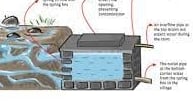

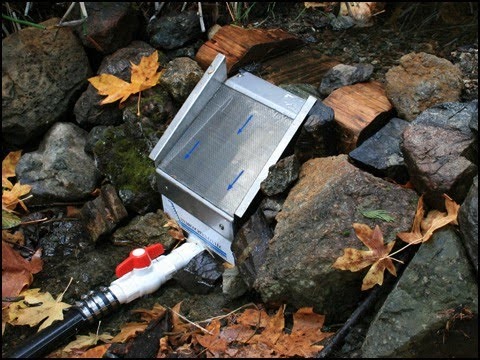

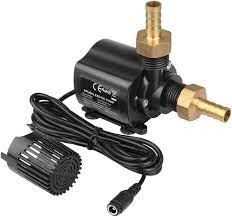

but if there is enough flow in your river, you should consider a electricity free pump called a ram pump
Powered only by the flow of water, there have been some working for close to a century without stopping, reliable, long lasting, cheap, easily diy able.
Invented by the Mongolfier brothers the inventors of the hot air balloons
Now, If you don't have a river available, you may have a small creek, or there’s maybe water running very shallow underground,
Take a walk with a shovel, and dig different spots in the most humid, greenest, deeper zone, on your land,
You might be lucky and find a shallow ground source where water seeps out of the ground, , depending how much water comes out you’ll need to trap that water and you could use an intake such as the one we saw for preleving water along a river,
Or You could use a hard plastic to trap and funnel the water to the intake. And thus gather more water on a largest area.
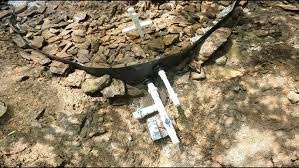

If no shallow water is detected you'll have to go deeper… first you need to find where to dig and then, well… dig…
You could go with a mystical but trusted wizard called a water dowser
or rather a fancy equipped, modern professional
If water is found, you'll have to dig and you could either go for a traditional well, which is a lot of work, and dangerous, i tried… probably better call a professional…


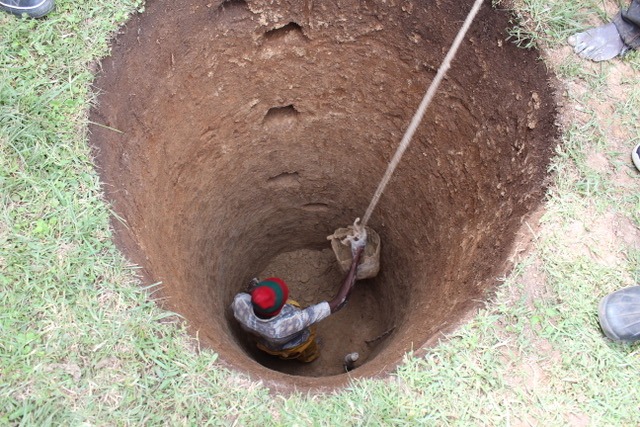

Another way to go is to drill a borewell, a very small-diameter well, dug thanks to high-pressure water being injected, or water more diy with less pressure and air, drilling, letting a hollow tube drop or just hammering a pipe in the ground, it’s an Easier and cheaper process overall, It can provide you a lot of water if you manage to tap in a good underground source.
Once the hole is dug consolidate it with pvc tubes with a filter at its extremity and then, a submersible pump goes in. ready to go.

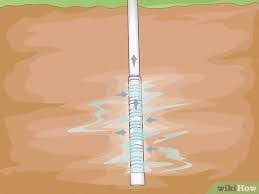
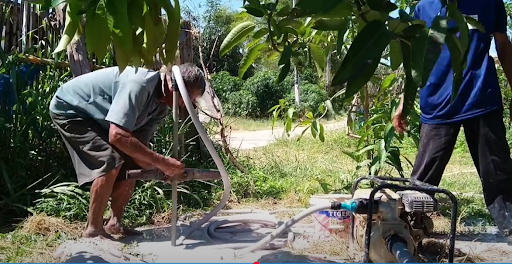

So, to move water up, from the well or the stream, or from a tank to the other, you’ll need pumps. They come as follows: manual pumps robust and reliable, but it’s a little outdated let’s say…
And electric pump.
they come in different voltages such as 12dc volts and 110ac volts, they can be powered directly from solar pannels, from your battery, you’ll need an inverter if you want to use a 110 alternative current pump or a generator.
They greatly vary in capacity, Electricity, consumption, and price…
If your pump doesn't work right away it's probably that it's not a self-primed type,which means you just need to get the air out of the system, so fill the system up with water at its higher spot. By the way That’s something you'll also need to do if you want to use gravity, the suction will start only when there’s no more air in the system.
And fun fact, Today, with 3D printing, you can even make your own small pump, using a little electric motor and printing the rest, and save some money that way.
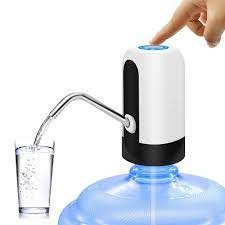

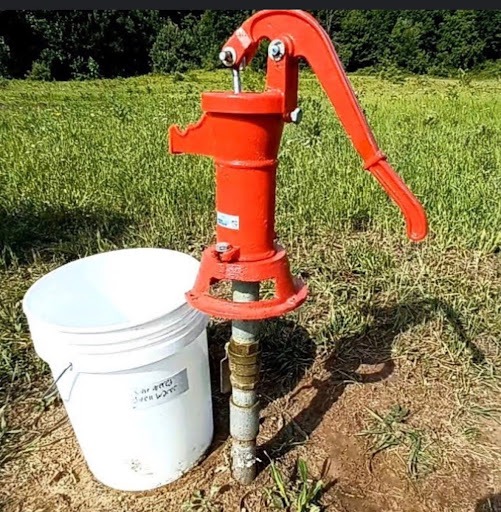

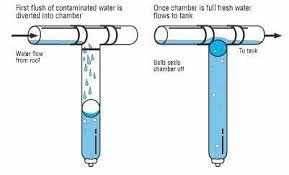

Rainwater is another great source of water,
Even if you already sorted your water problem, with a river or a creek, for redundancy purpose you should catch the water falling on your roof too…
Youll just need some kind of gutters, many different styles are available for different roof type and material.
To upgrade that sys. you could embed a first flush system. It’s a way to discard the first 5 to 10 minutes of a rain so the roof and gutter are flushed of all debris, bird poop, and other things you don’t want in your tank.
if the tank that’s being filled is higher than the faucet, you won’t need any pump to use that water, let gravity do the work.
If no ground water is available It doesn’t rain enough but you are close to the sea, then you could desalinate water…
You have different options, more or less expensive. The most efficient, conventional and expensive would be a reverse osmosis system, ranging from $300 to $10k for “private” units to hundreds of millions for industrial plants.
The cheapest ones, would give you one gallon per hour.
They will need new membranes every few years, depending on usage. The membranes are relatively costly.. And fragile, especially to chlorine, but also simly to dirty water, you should have a good prefiltration sys. To make your unit last.
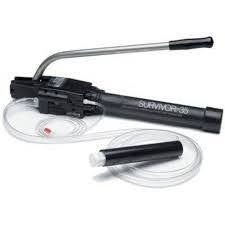

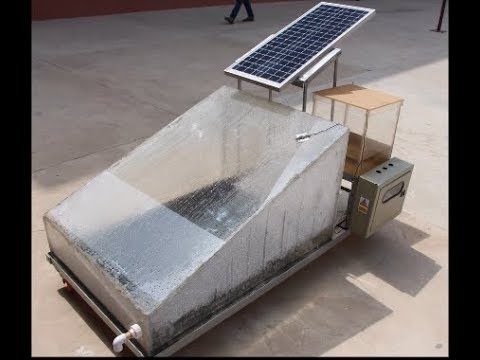

A much more low-tech and less energy intensive option is a solar still. In other words simply collecting evaporation.
A lot can be done to make it more efficient. Could be as simple as letting water evaporate in a closed space and collect the condensation.
Or upgrade the system, for example, preheating the water and letting it sip through a black fabric behind glass and collect the condensation, the system could be further enhanced with a cold plate to boost condensation, the most efficient version of those is a recent MIT innovation, they came up with a very interesting new concept, which keeps the system clean for the salt accumulation, and it seems pretty efficient…
you could also turn to a much more Mad Max approach—simply distilling seawater with a heat source, which could come from your heating or cooking system or a dedicated rocket stove boiler.

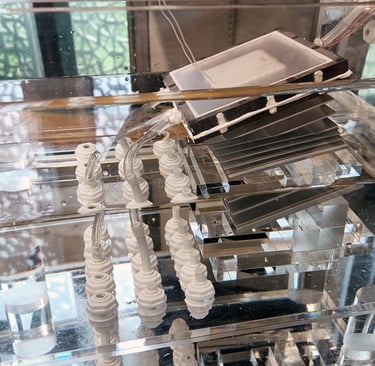
From the air
If you don’t have no river, no ground water, no rain and no sea
You could still harvest water from the air, you could turn to a humidity catcher,
The idea is to catch the moisture present in the air, so the more humid is your plac
e the better, especially at night, put up a fabric vertically, on which the water will condense, it then runs down along the fabric, collects in a gutter, and slowly but surely refill the tank.
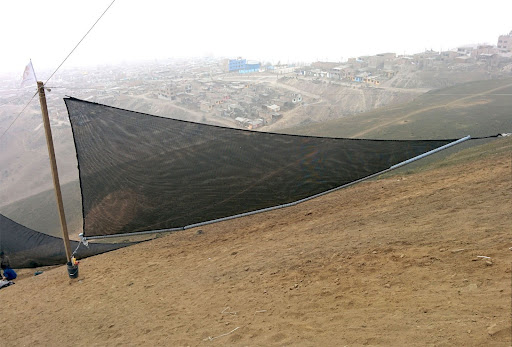

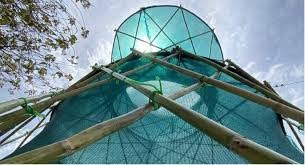

The high tech version of that is an atmospheric water generator, pretty energy intensive but it works… it actually works very similarly to a a air condiscioning unit
Hot air can retain much more moisture then cold air, so when the air is cooled water condensate, drop by drop, you are collecting water.
Could be made with fridge type compressor or also with peltier modules, which when connected to electricity will produce heat on one side and cold on the other.
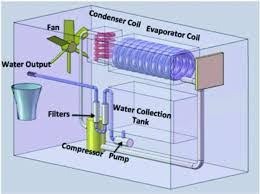

For your resiliency it would be best to set up at least 3 different water sources.
if you want to be truly off-grid and have peace of mind that your needs will be covered, you should work on the redundancy of all your systems, but its obviously especially true for water…
The more remote you are, the more you'll need a backup for the backup and storage.
Next, let's talk of ways to store the water we gathered.
Here again for redundancy purposes and ease of use, the best is having a multiple reservoir system: a huge one for long-term storage, a smaller one for short-term usage, where you store pre filtered water, and a smaller last one for double-or triple filtered water meant meant for your daily usage for drinking, and cooking and bathing to eventually…
It’s good to check regularly on your tank, making sure everything is fine and checking levels and occasionally cleaning it. You'll need to learn how much you use, how much time you’ll need to fully refill it, etc…
To have a better feel of your water autonomy, you could use some kind of indicators to let you know how much you still have.
It could be a floater connected to an indicator, various electric float switch, to let you know with various lights indicator the tank level, or a few analogique car fuel gauge, could also be an ultrasonic depth sensor connected to your smartphone via bluetooth, or displayed through wifi on the house dashboard screen…
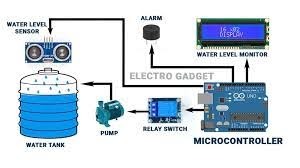

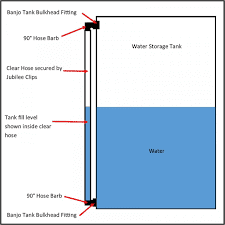

About the storage container itself, you have many materials and designs to choose from, eventually also burying them or not... Let’s talk about materials.
Cheaper and more accessible for small systems is to simply use plastic containers, repurposing fuel tanks (like we do on the island), using farmer water containers, or buying specifically designed water tanks from your local tool shop. It’s a long-lasting option, but you’d better keep it out of the sun. It’s great for small systems, but larger plastic tanks are quite expensive,
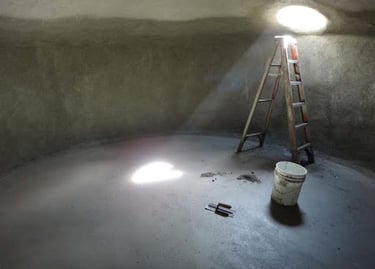

so some people go for a brick and cement cistern. If you are choosing cement,
You could also opt for the ferrocement option. It simply means applying cement on a metal structure. The metal structure is finished with a chicken wire type of mesh ciment is then projected on it, it allows for complex shape, thus you can tailor the cistern to your spot and save some heavy lifting earth work,
Feerrociment is a material also used in boat construction
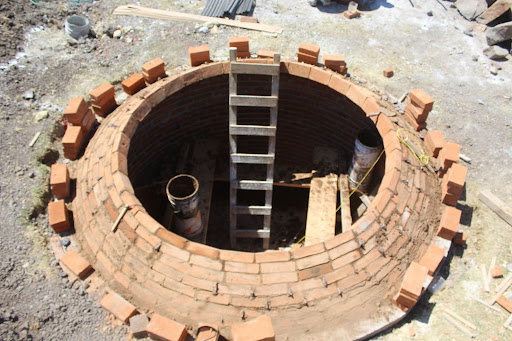

In a smaller space set up such as a boat or a van you could choose flexible reservoir, they collapse on themself, and are easy to instal in tight space.
You also have the option of using metal, possible in aluminum, or stainless steel would be best.
A cheaper and more diy friendly option would be plywood reinforced with fiberglass, using an epoxy resin to be 100% watertight protecting the wood. Add then a few coats of food grade paint and you are good to go!
Whatever material you’re choosing, you should monitor your reserves to be sure you don’t have leaks, eventually fixing them is also very important to keep the tank clean and cool to prevent
the development of life in there.
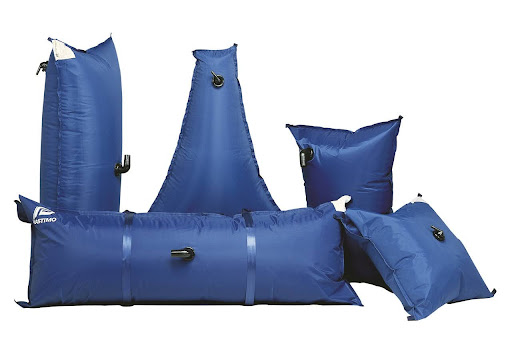

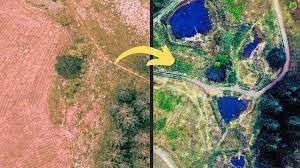

Another way to improve your water resiliency is to store it directly in the landscape. That will be discussed more in the permaculture chapter, but the idea here is to help rain infiltrate into the soil, digging leveled swales, a recharge pit or redirect rain runoff into an interconnected pond system, also shading humid spots, or putting mulch on your land, this should recharge your ground water wich could also completely transform youe land for the better and securing more water available for your food production and water security in general.
Let’s now talk about using this water : filtration for drinking water, pressurized systems, hot water solutions, ways to save on water, and gray water management…
Filtration first, you have to understand there are many types of water contaminants, dust and particles, microbes, viruses, chemicals, heavy metals, and more…
there is not a single water filtration method that can be 100% safe for all of the above…
For instance one of the best filtrations is through reverse osmosis, the technology used to desalinate water, but some small molecule pesticide could still pass through…
A mix of techniques and redundancy of systems is here again key to your long term off grid homestead.
depending on the quality of the water, you first want to prefilter it, just through rocks gravel and sand at first, if you had active charcoal in there that d be already a pretty decent set up,
Such a system is easily DIYable, and Let the water sip through that, and it comes out pretty clean on the other end. But nothing is guaranteed 100% with that,…
So see it as a first step,
You could then simply boil that water, here you are sure to kill all biological contaminants that may remain in the prefiltered water.
Or easier with a Berkey type filter, basically a clay pot with activated carbon filters.
Another option would be with that same clay, but painted with a coat of colloidal silver bio filter. The overcooked clay lets the water sip through, and the silver kills bacteria, and prevent growth. Unlike the activated charcoal filter that has to be kept very cleen.




You also have multistage filtration system , same kind that a pool would use, not really enough to be 100 % sure the water is safe, from bacteria and viruses unless you finish that system with a special filter that’s proven to remove the smallest contaminators, such as Ultrafiltration filters,
The diy option for that is finishing that system with survival personal straws, those are cheap and proven effective for microbes,
Instead of sucking on it, plug it to a small pressure pump water will be forced trough and will provide very safe water.
Those pipes have their limitations,
arround xxx. before change
They will slowly clog up, but if the water is well prefiltered they'll last pretty long…

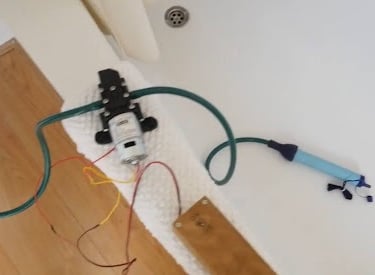
Another approach to kill biological contaminants is through UV exposure. Using high-tech UV light treatment or the low-tech option, simply in glass or plastic bottles left in the sun…
but keep in mind here you're only killing bacteria and viruses and not filtering contaminants, you could use that technique in addition to one of the previous ones.
Theres also dessalinisation systhems that you can find on page xx .
That double / triple filtered water could then be stored in small daily tank ready for daily usage, a small pump could then deliver it in a convenient way or gravity once again…
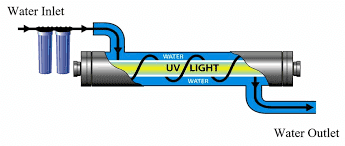

Next up is water to bathe:
So you don't necessarily need perfectly filtered drinking water to bathe,
water from the prefiltered tank should be enough, to be avoided if you have open wounds though…
To get the water to the shower head you have 2 options, If the tank is higher than the shower head, but the pressure will depend on the tank level compared to your faucet.
but it might just be easier to install and more comfortable to have a water pump feeding water from the tank, could be a foot pump, an aquarium type pump, or even a pressurized water sys.
It’s quite cheap and easy to do so with an on-demand pump, which will kick in every time you open the faucet, but be carefull cause that's also gonna make you use much more water!
Hot water, Another luxury, thats gona make you use much more of that precious ressource under the shower.
We have many ways to heat water up >
There's a few low-tech approaches,
In a hot climate it could just be refilling a day tank and letting it exposed to the sun all day, the same systhem could be more efficient by building a small green house arround the resservoir, capacities vary depending on how hard the sun hits and the outside temperature at your location it…
but if you neeed more heating power, you could build a thermal solar pannel, in wich the water is traveling in a pipe or some sort of heat exchanger exposed to the sun and painted black, on the most efficient version water is passed in a vaccumed glass tube, reaching crazy temperature that method is also used for siolar coooking.
With the help of pumps, The systhem could be connected to the main house water boiler and so eventually the heating systhem, such as floor heating
In a more DIY spitit you commonly find those units mounted with the reservoir right on top of it. This allows for a natural process to replace the need for pumps…
Cold water sinks, hot water rise…
called thermosiphon effect.
it s advised to have a small reservoir so the water doesnt stay hot for to long, harmfull bacterias could quickly devlop in it

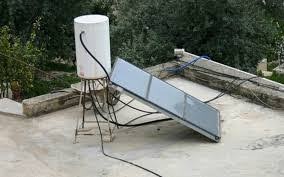

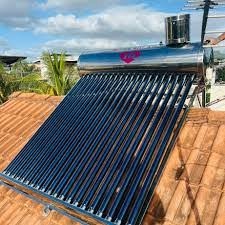
Another method would be,
using fire from your cooking or from your heating system to heat it up, with such a systhem youll make a double usage of your fire fuel…
But it could also be a dedicated small rocket stove such as that one. Fast and easy to use,
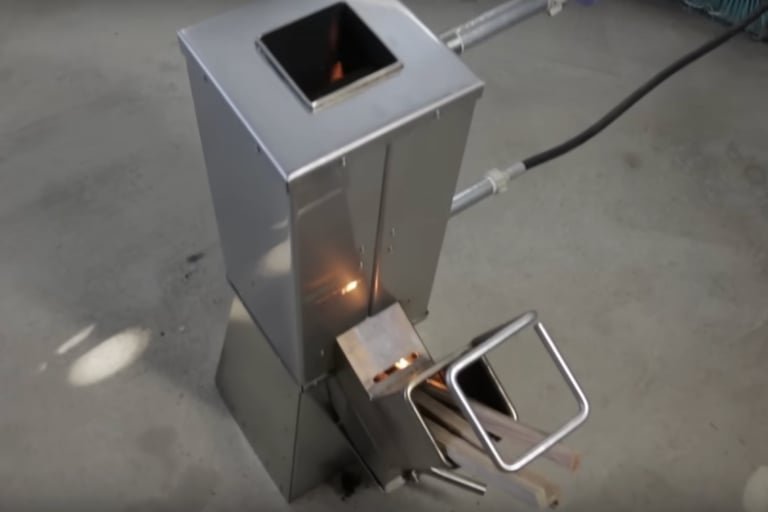

And last, surprising, unexpected, but functional and stable all year long, is to use a pile of compost, the temperature reach 70 degrees in its core and very stable, even in winter, free heat and quality soil… proper composting is an art and using that technique will force you to do it right as you’ll be monitoring the temperature…
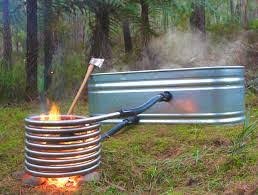

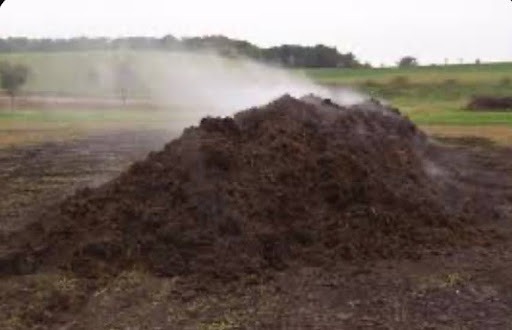

Fossil fuel and Gaz boiler,
It could be something like a big ressidencial unit , mazout, diesel, gaz..
Or a much more compact gaz systhem, on which you plug a regular gaz cooking bottle, reliable and easy to connect to a regular modern house water systhem…
It could also be run from your own biogaz production… with a few pigs you could produce a lot of gaz and some chuletas.

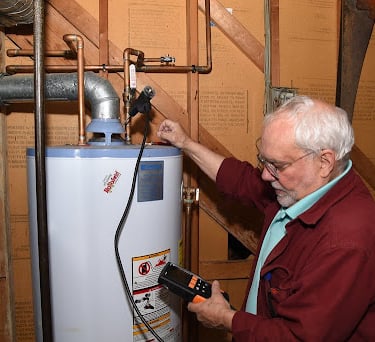
Saving on water
If water is very scarce for you, or simply really care about this scarce resource, we’ll see here a few ways to reduce your usage…
Starting with another way to shower, it s used in space by the astronauts, instead of delivering water in its liquid form it is instead delivered in a mist form, creating a thick cloud enough for a proper wash, it doent feel the same, and to reach a comfortable temperature you ll need to heat the water at higher temperatures, cause the tiny dropllets of mist loose their heat very quick.
Some people have choosen to grow mushroom in their misting shower to give a double use to water used for showering.
To save on water, you could also simply reduce the flow at your faucets.
You could use the penny method, drill a coin and put it in your faucet or shower head intake, i know its an investment but it as a great ROI.
Or simply add a valve that you have open just as much as needed, for the sufficient flow.

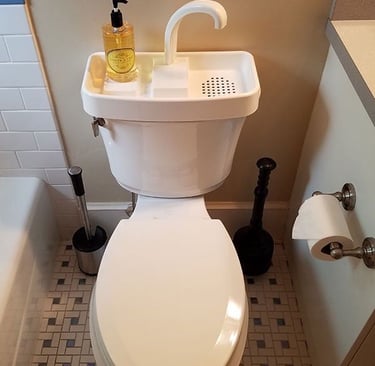
Here's other ways to save up on water.
Reuse the water to fill up your toilet flushing system, for instance, could do the same with the shower water too..
But even better to save on water would be to simply stop using water for your toilets…
instead go for the compost toilet option… it can be very clean and completely odor less if well designed… see in hygene section page xx .
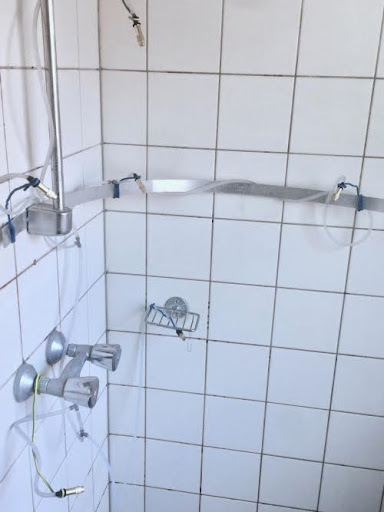

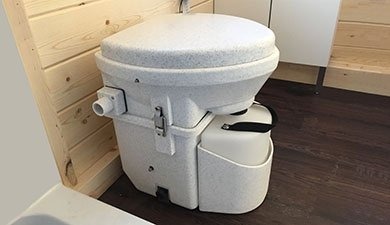

For the shower you could also think of a shower loop recycling system. Filtering, reheating and Repumping the water back up, it sounds gross, but the water will be filtered… you’ll need to stop peeing in the shower though…
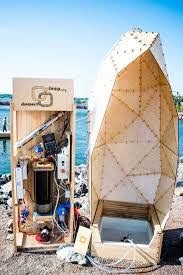

If not any of that at the very least, have the piping system bring that water to your garden to feed your plants. Same for your kitchen sink water, which also has the advantage of being nutrient-rich with all those food scraps.
The best way to do that is to have a dedicated gray water filtration system, It simply means a zone where the water will be filtered, first by gravel, and/or sand and resilient plants before going to a garden you want to boost.
A simple pipe going to the garden works great to… just be sure never putting bleach or another, chemical.
Would also be better to be using natural soaps and products and we’ll see in another section how to do that. Section hygene Page xx .
The gray water could also be harvested to feed a Pipe system that will be feeding water drop by drop to your favorite fruit trees.
When i builded the shower under the maranion tree at my place, as it was used by a whole team of volunteers as well the tree started producing like crazy and growing quicker in only a few month, a very direct greyish water sys.

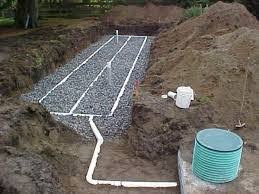
Conclusion:
Water is the most important aspect of any off-grid setup.
Whether your main supply comes from tapping into a stream, a borewell, or catching rain from your roof, redundancy is key. One source can fail ; three sources at least makes you resilient. Pair that with enough storage capacity and you should be good.
Just dont forget to filter it before drinking, remember No single method is perfect, but stacking techniques—sand pre-filters, activated carbon, UV treatment, or reverse osmosis—ensures safety.
And try your best to not waste a drop.
Go build yours